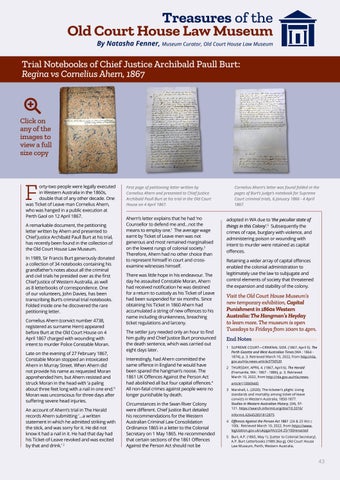Treasures of the Old Court House Law Museum
By Natasha Fenner, Museum Curator, Old Court House Law Museum
Trial Notebooks of Chief Justice Archibald Paull Burt: Regina vs Cornelius Ahern, 1867
Click on any of the images to view a full size copy
F
orty-two people were legally executed in Western Australia in the 1860s, double that of any other decade. One was Ticket of Leave man Cornelius Ahern, who was hanged in a public execution at Perth Gaol on 12 April 1867. A remarkable document, the petitioning letter written by Ahern and presented to Chief Justice Archibald Paull Burt at his trial, has recently been found in the collection of the Old Court House Law Museum. In 1989, Sir Francis Burt generously donated a collection of 34 notebooks containing his grandfather’s notes about all the criminal and civil trials he presided over as the first Chief Justice of Western Australia, as well as 8 letterbooks of correspondence. One of our volunteers, John Davies, has been transcribing Burt’s criminal trial notebooks. Folded inside one he discovered the rare petitioning letter. Cornelius Ahern (convict number 4738, registered as surname Hern) appeared before Burt at the Old Court House on 4 April 1867 charged with wounding with intent to murder Police Constable Moran. Late on the evening of 27 February 1867, Constable Moran stopped an intoxicated Ahern in Murray Street. When Ahern did not provide his name as requested Moran apprehended him, but Ahern resisted and struck Moran in the head with ‘a paling about three feet long with a nail in one end.’1 Moran was unconscious for three days after suffering severe head injuries. An account of Ahern’s trial in The Herald records Ahern submitting ‘…a written statement in which he admitted striking with the stick, and was sorry for it. He did not know it had a nail in it. He had that day had his Ticket-of-Leave revoked and was excited by that and drink.’ 2
First page of petitioning letter written by Cornelius Ahern and presented to Chief Justice Archibald Paull Burt at his trial in the Old Court House on 4 April 1867.
Ahern’s letter explains that he had ‘no Counsellor to defend me and…not the means to employ one.’ The average wage earnt by Ticket of Leave men was not generous and most remained marginalised on the lowest rungs of colonial society.3 Therefore, Ahern had no other choice than to represent himself in court and crossexamine witnesses himself. There was little hope in his endeavour. The day he assaulted Constable Moran, Ahern had received notification he was destined for a return to custody as his Ticket of Leave had been suspended for six months. Since obtaining his Ticket in 1860 Ahern had accumulated a string of new offences to his name including drunkenness, breaching ticket regulations and larceny. The settler jury needed only an hour to find him guilty and Chief Justice Burt pronounced the death sentence, which was carried out eight days later. Interestingly, had Ahern committed the same offence in England he would have been spared the hangman’s noose. The 1861 UK Offences Against the Person Act had abolished all but four capital offences.4 All non-fatal crimes against people were no longer punishable by death. Circumstances in the Swan River Colony were different. Chief Justice Burt detailed his recommendations for the Western Australian Criminal Law Consolidation Ordinance 1865 in a letter to the Colonial Secretary on 1 May 1865. He recommended that certain sections of the 1861 Offences Against the Person Act should not be
Cornelius Ahern’s letter was found folded in the pages of Burt’s judge’s notebook for Supreme Court criminal trials, 6 January 1866 - 4 April 1867.
adopted in WA due to ‘the peculiar state of things in this Colony’.5 Subsequently the crimes of rape, burglary with violence, and administering poison or wounding with intent to murder were retained as capital offences. Retaining a wider array of capital offences enabled the colonial administration to legitimately use the law to subjugate and control elements of society that threatened the expansion and stability of the colony.
Visit the Old Court House Museum’s new temporary exhibition, Capital Punishment in 1860s Western Australia: The Hangman’s Heyday to learn more. The museum is open Tuesdays to Fridays from 10am to 4pm. End Notes 1 SUPREME COURT—CRIMINAL SIDE. (1867, April 5). The Perth Gazette and West Australian Times (WA : 1864 1874), p. 3. Retrieved March 10, 2022, from http://nla. gov.au/nla.news-article3750520 2 THURSDAY, APRIL 4. (1867, April 6). The Herald (Fremantle, WA : 1867 - 1886), p. 3. Retrieved March 10, 2022, from http://nla.gov.au/nla.newsarticle110069445 3 Marshall, L. (2020). The ticketer’s plight: Living standards and mortality among ticket-of-leave convicts in Western Australia, 1850-1877. Studies in Western Australian History, (34), 97121. https://search.informit.org/doi/10.3316/ informit.426452831812875 4 Offences Against the Person Act 1861 (24 & 25 Vict c 100). Retrieved March 10, 2022, from https://www. legislation.gov.uk/ukpga/Vict/24-25/100/enacted 5 Burt, A.P. (1865, May 1). [Letter to Colonial Secretary]. A.P. Burt Letterbooks (1989.36a-g), Old Court House Law Museum, Perth, Western Australia.
43
















